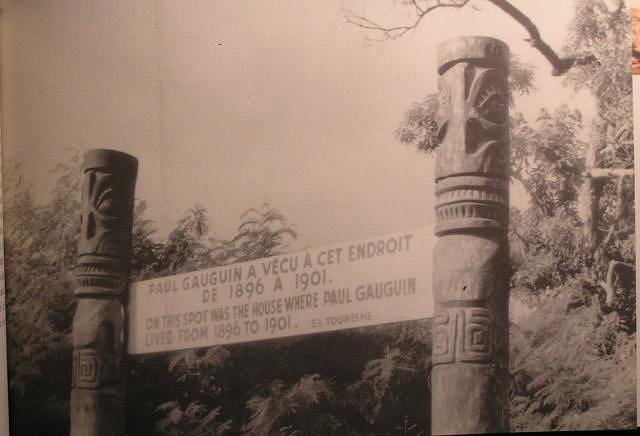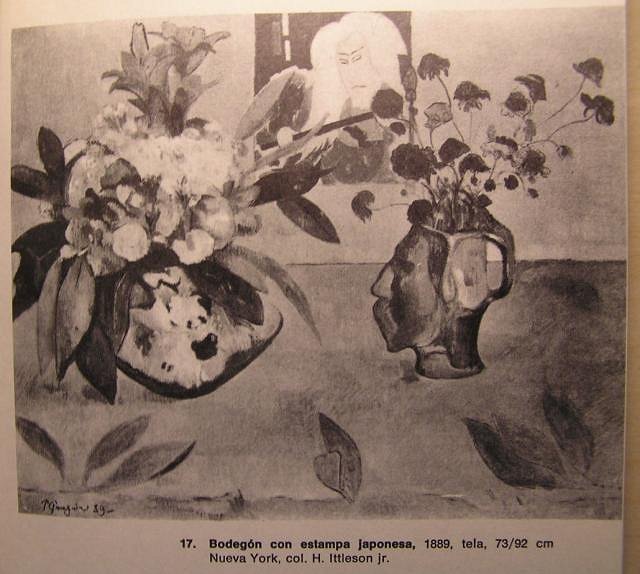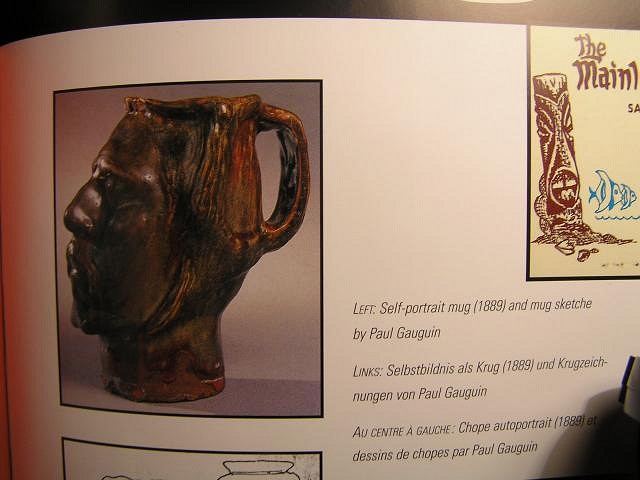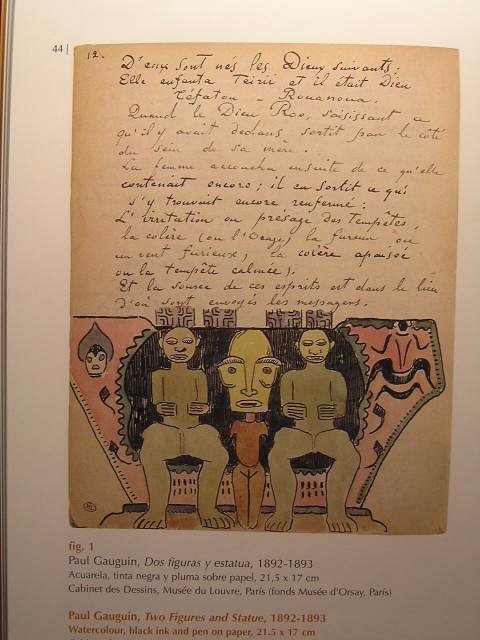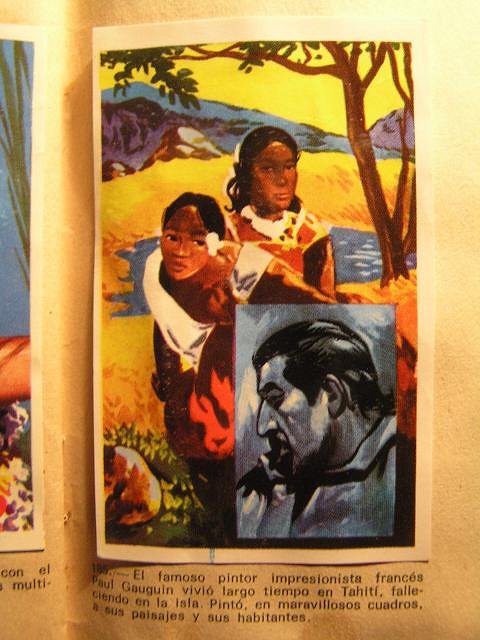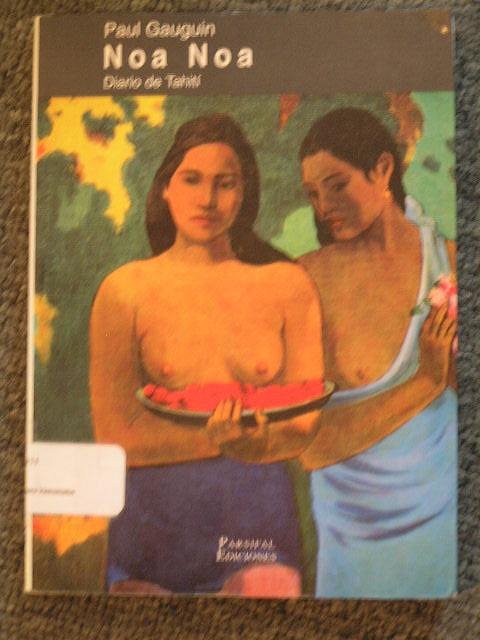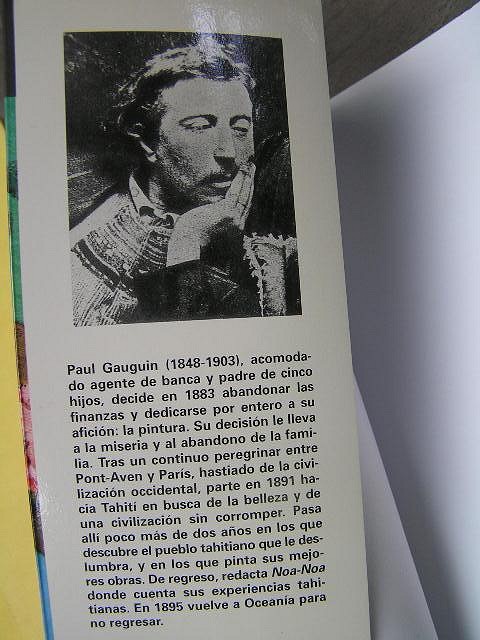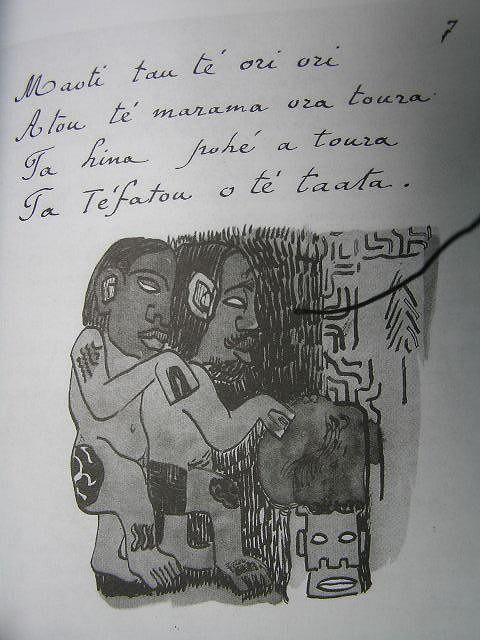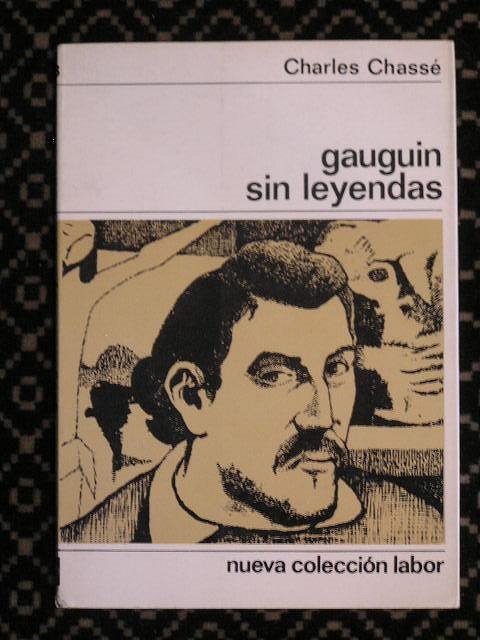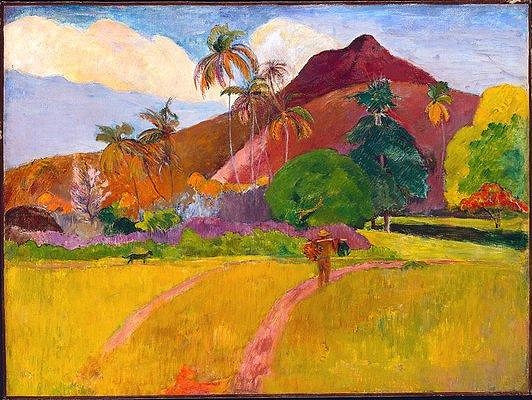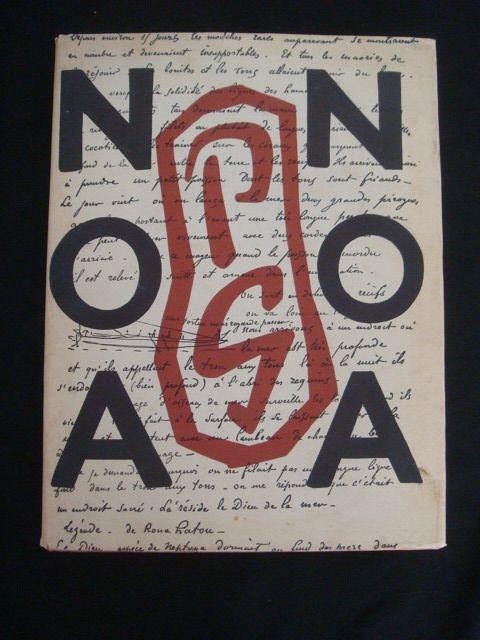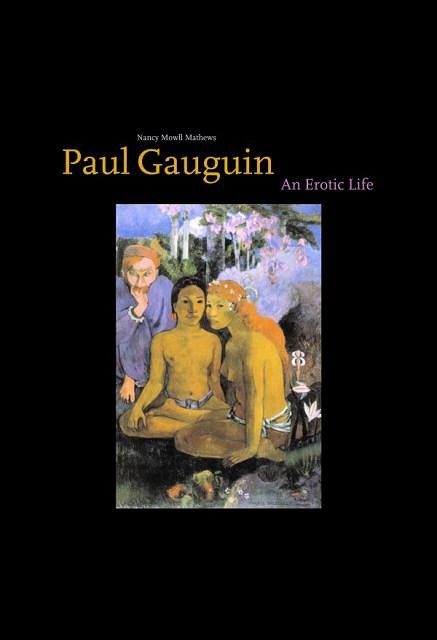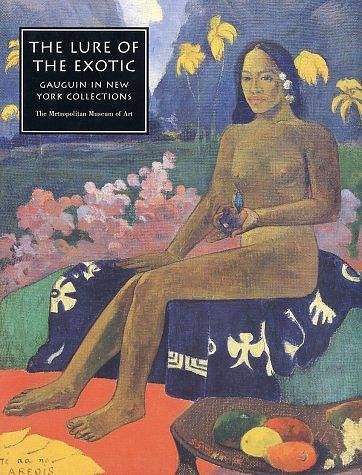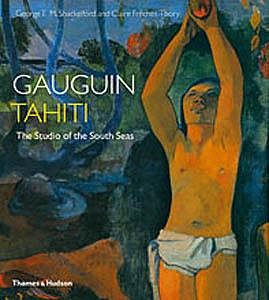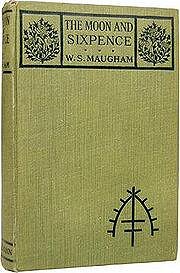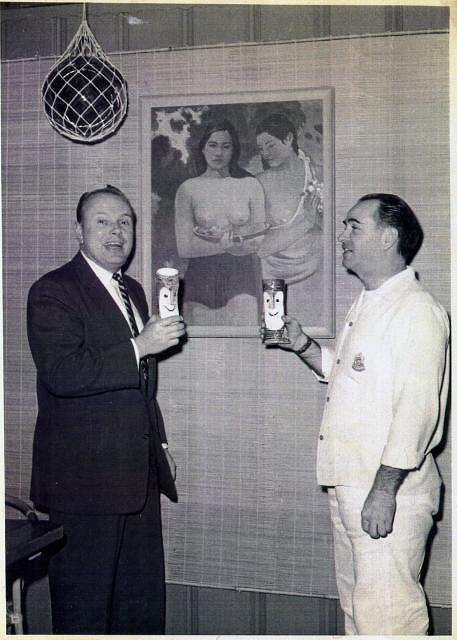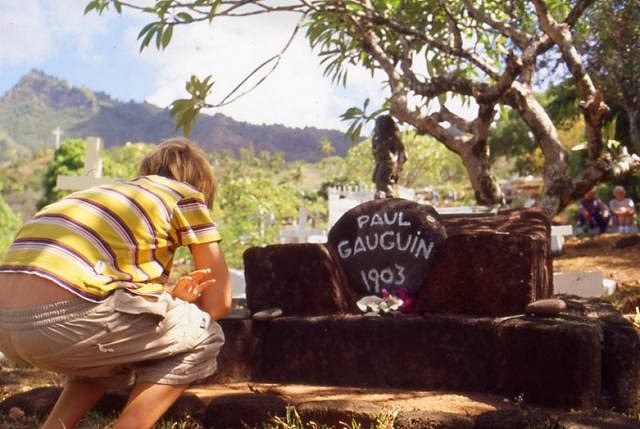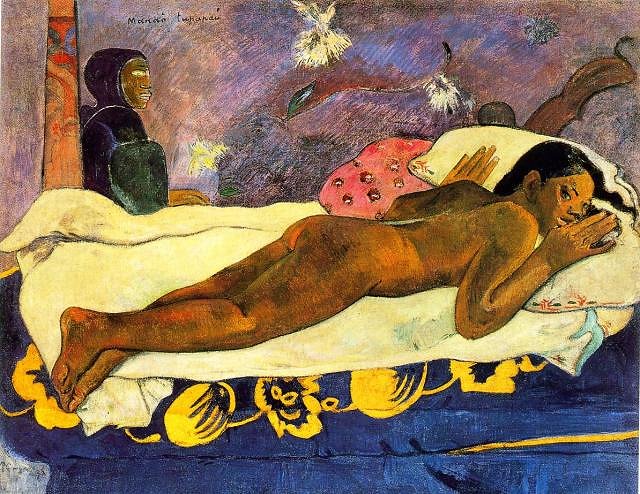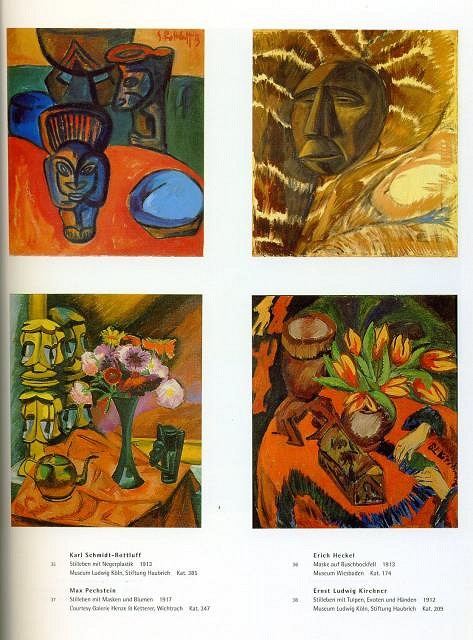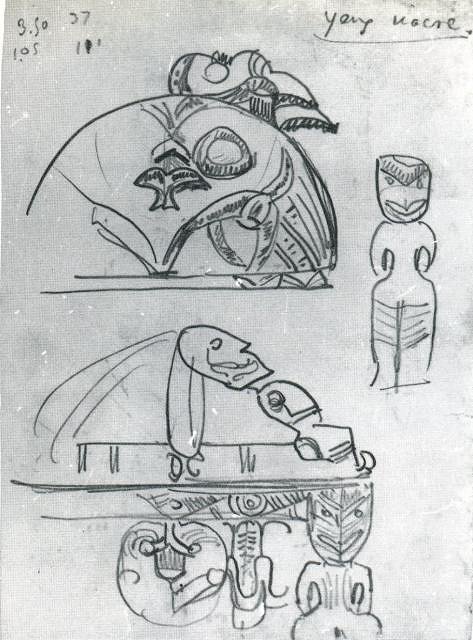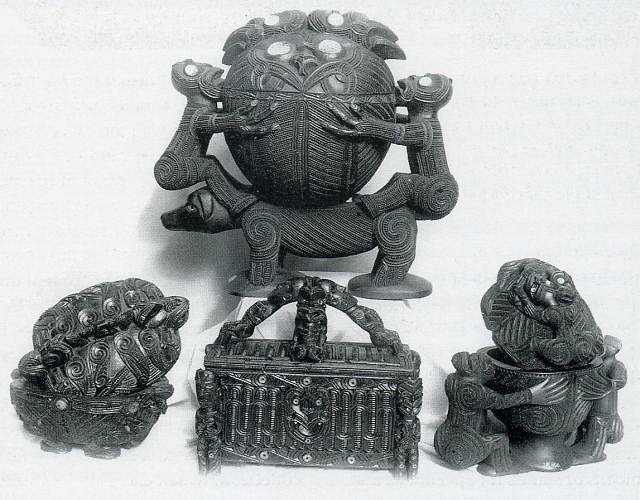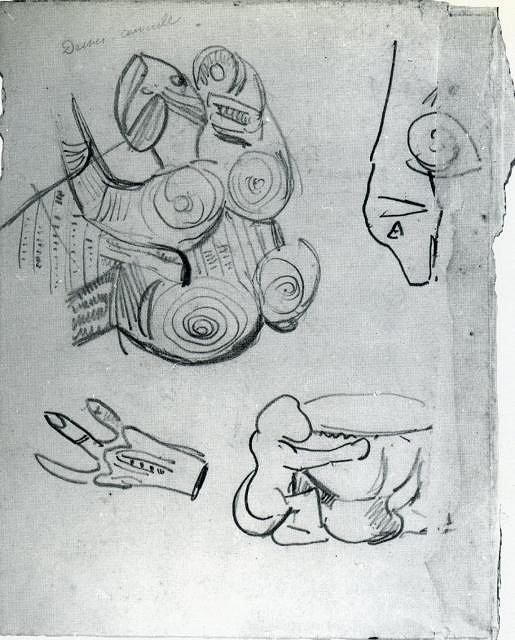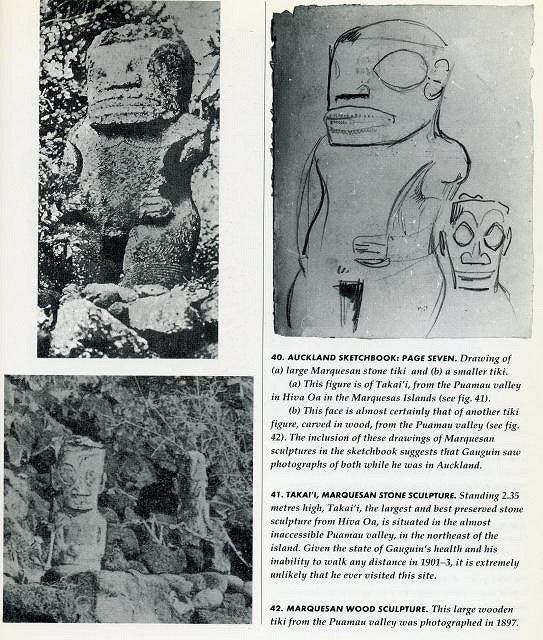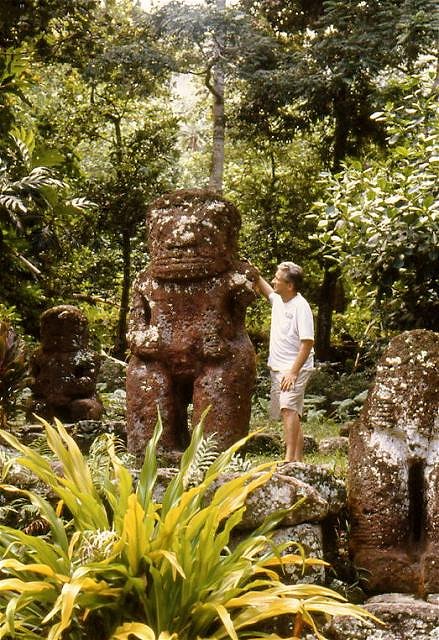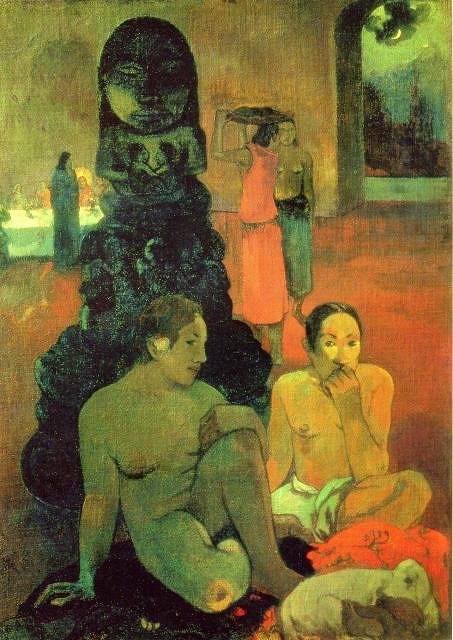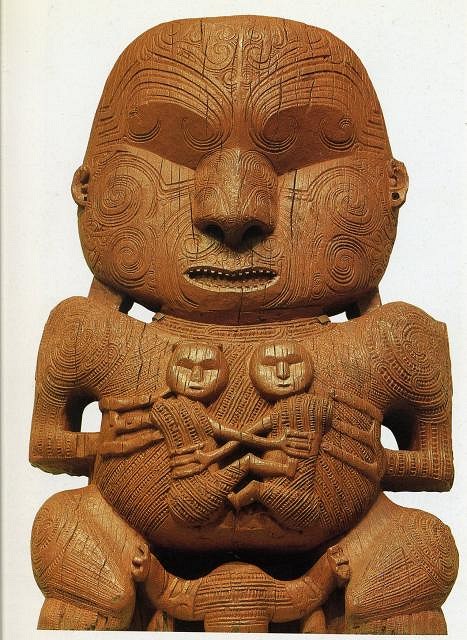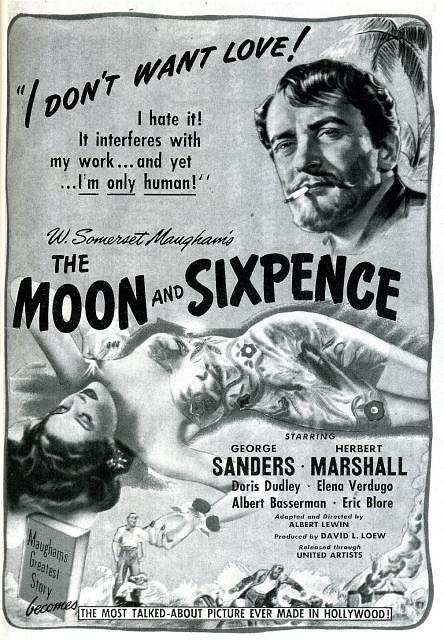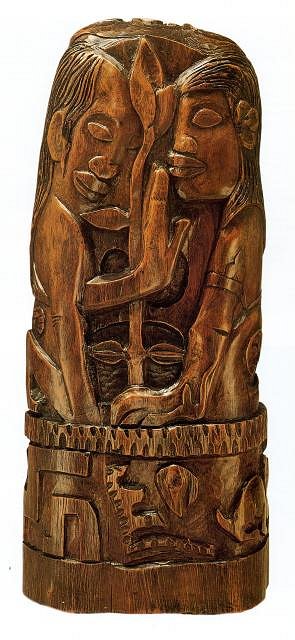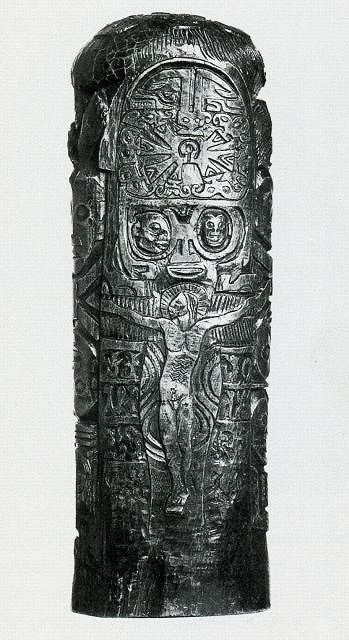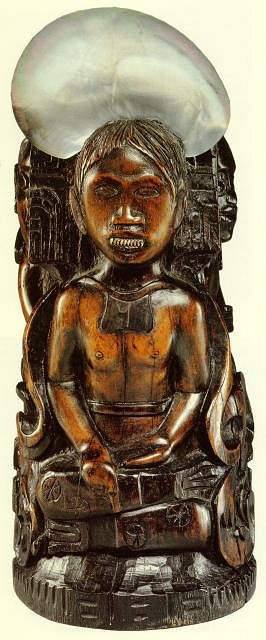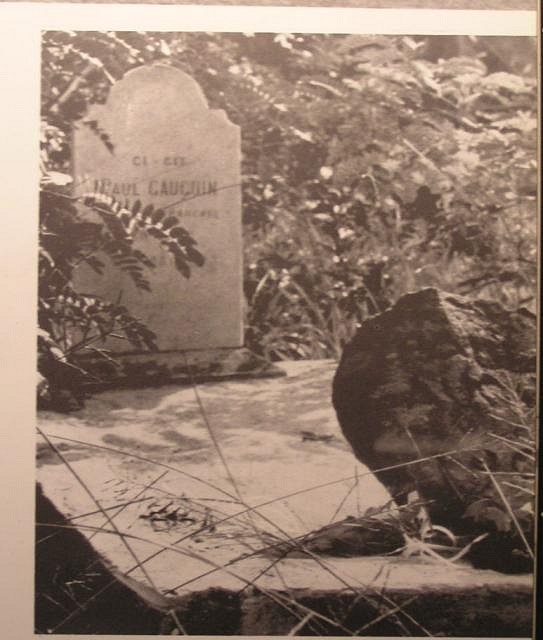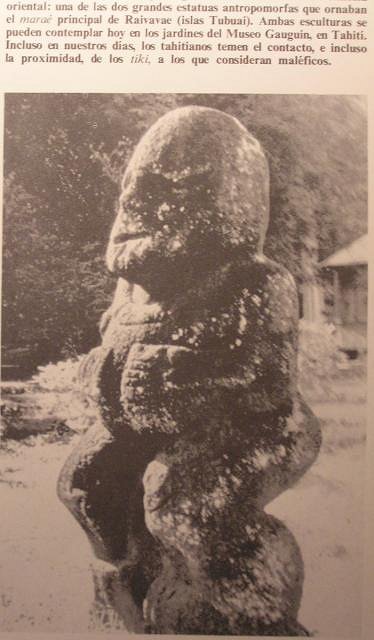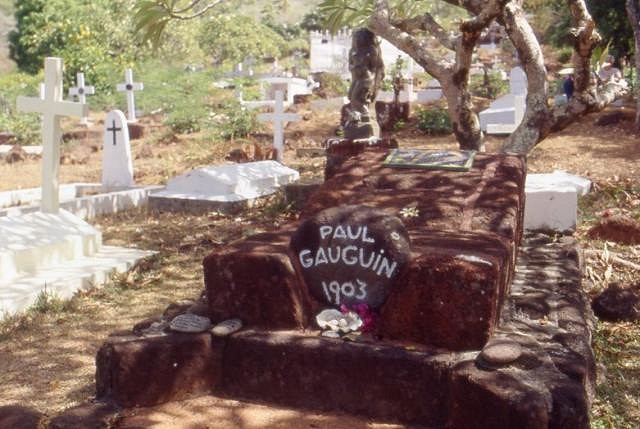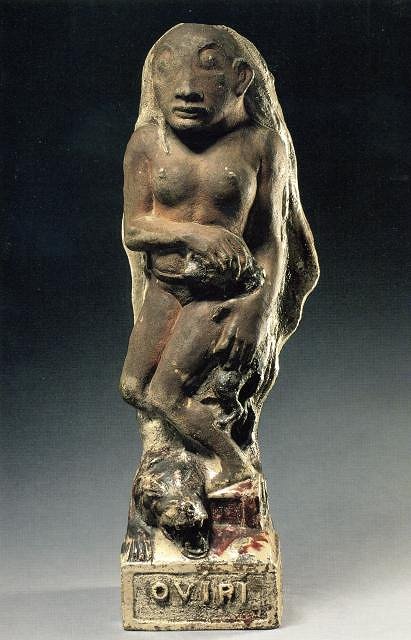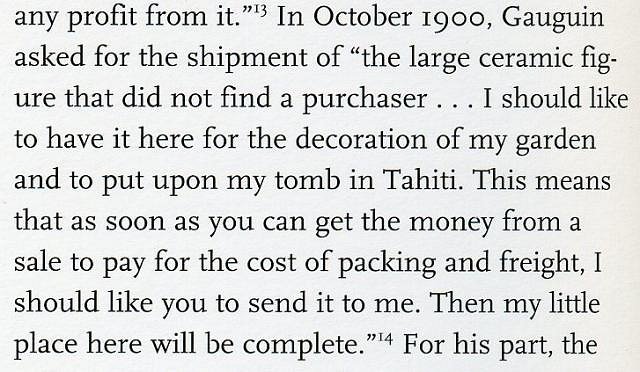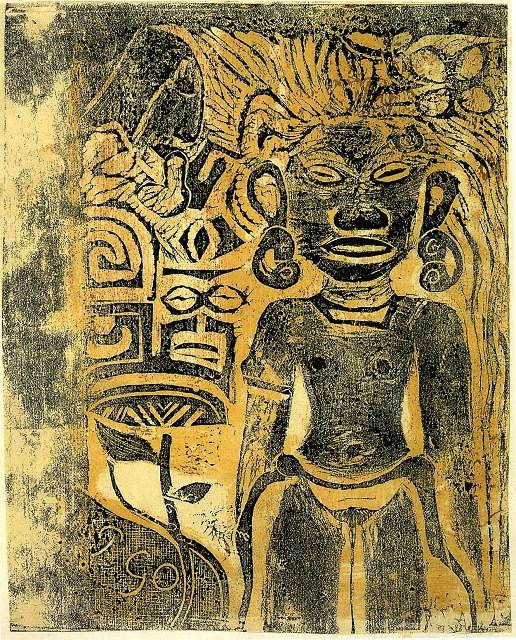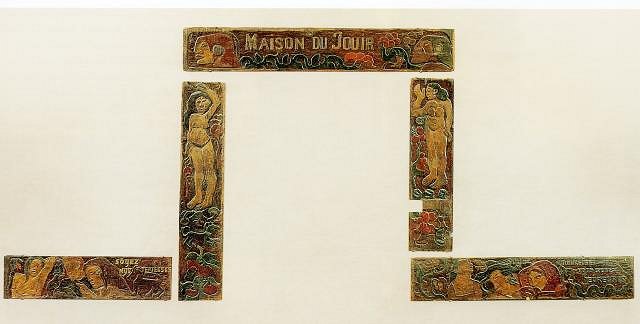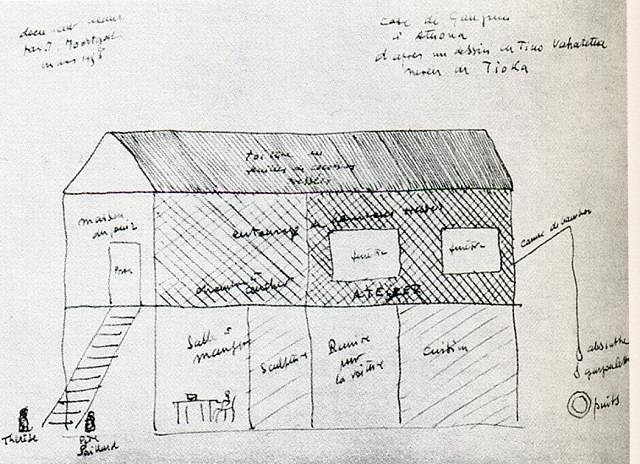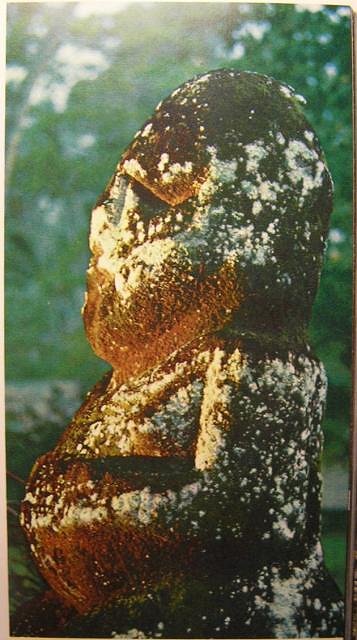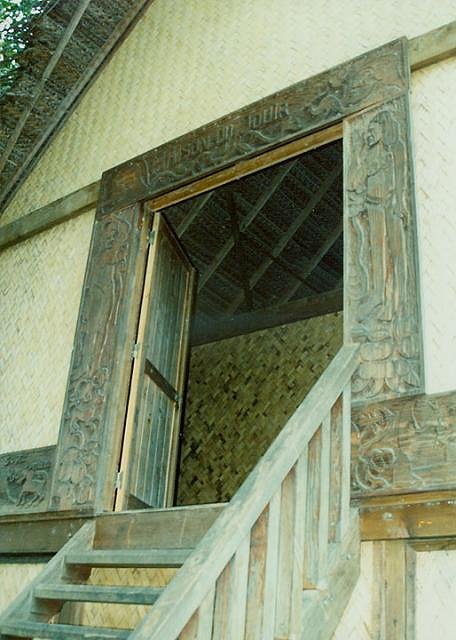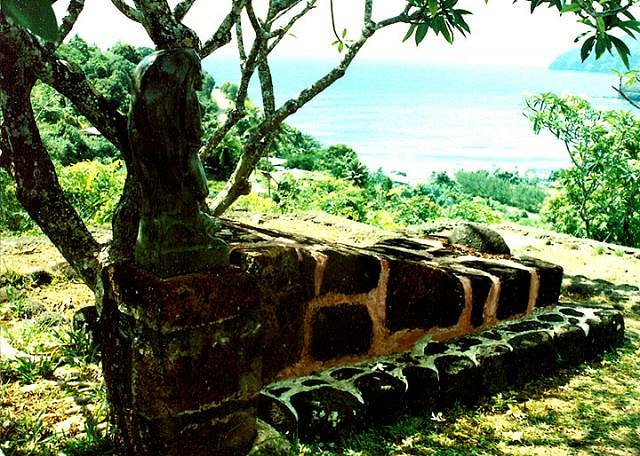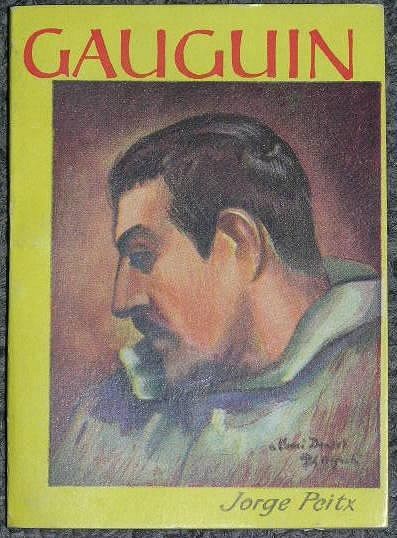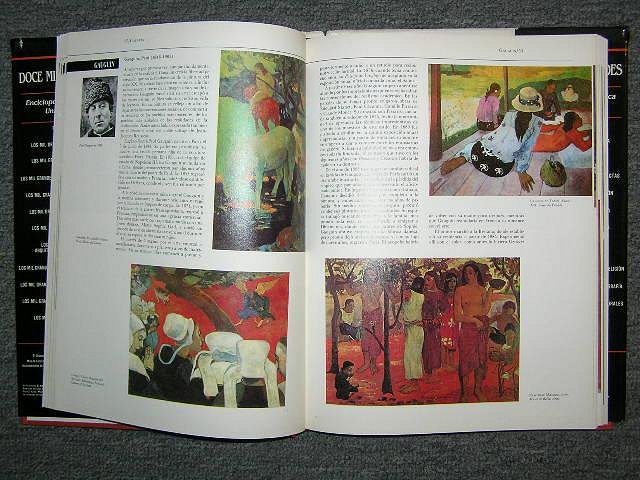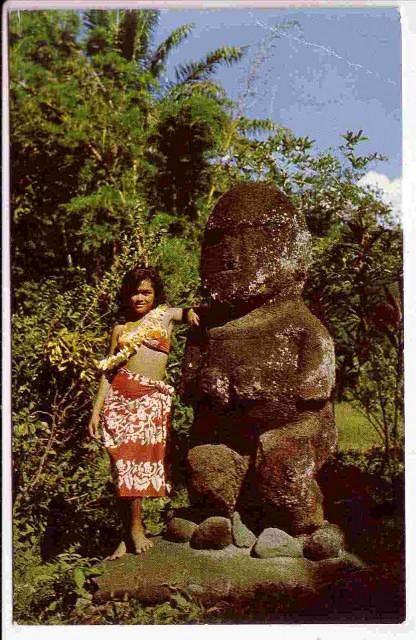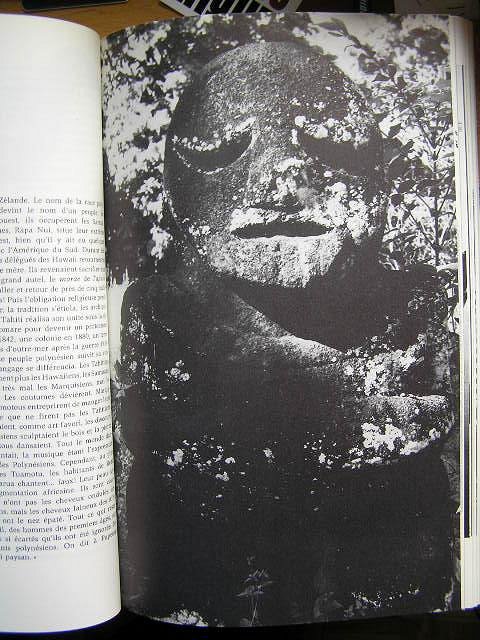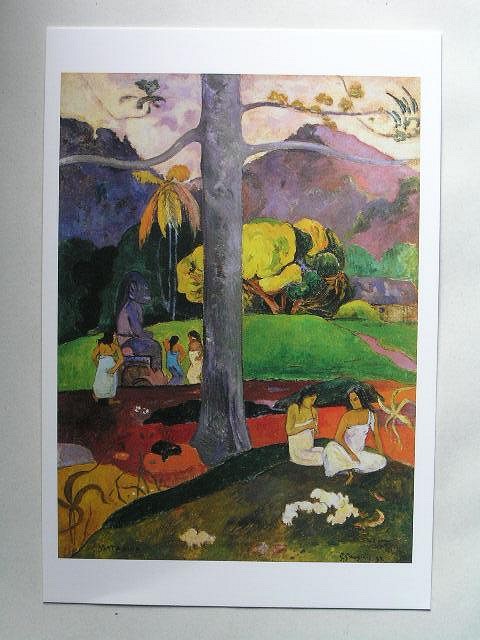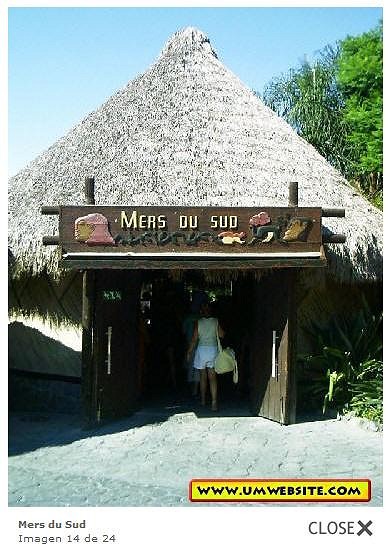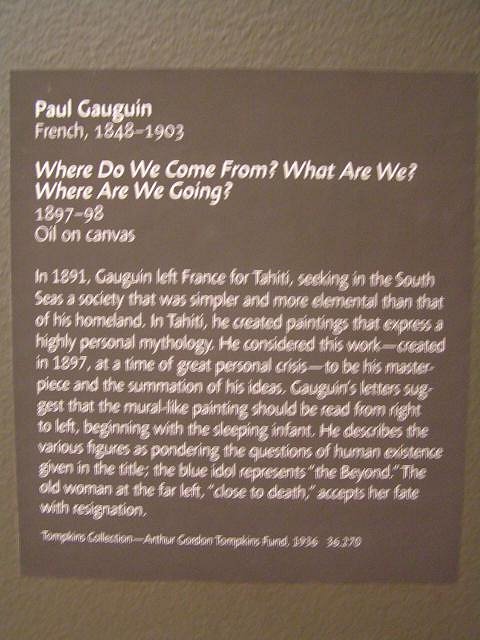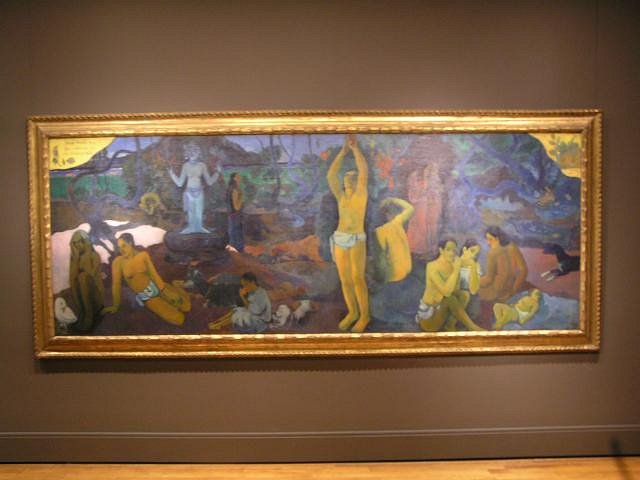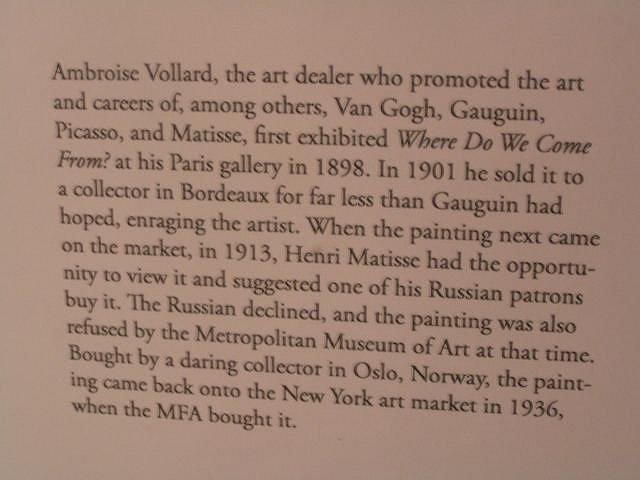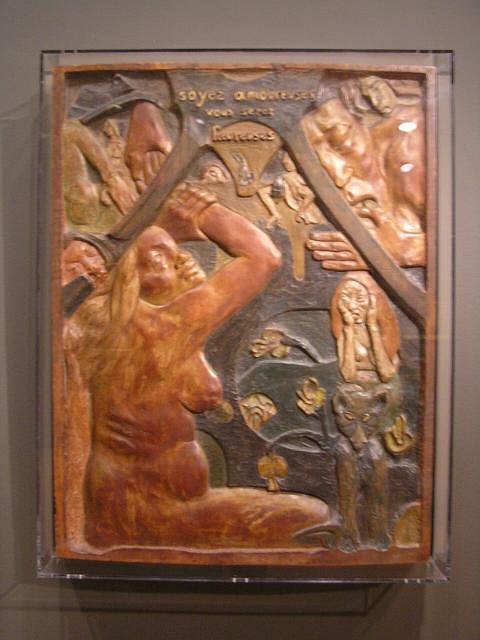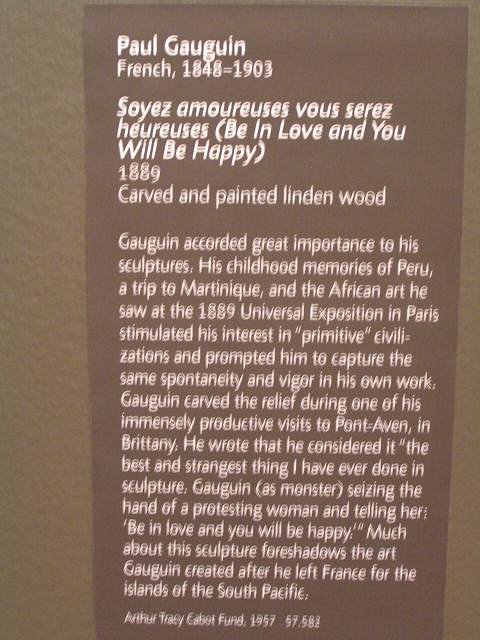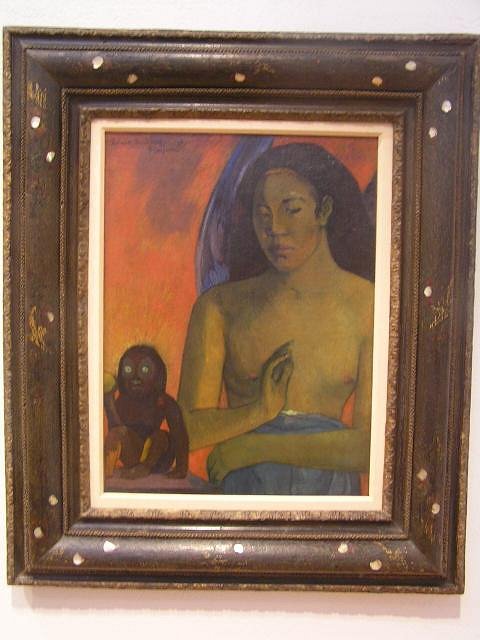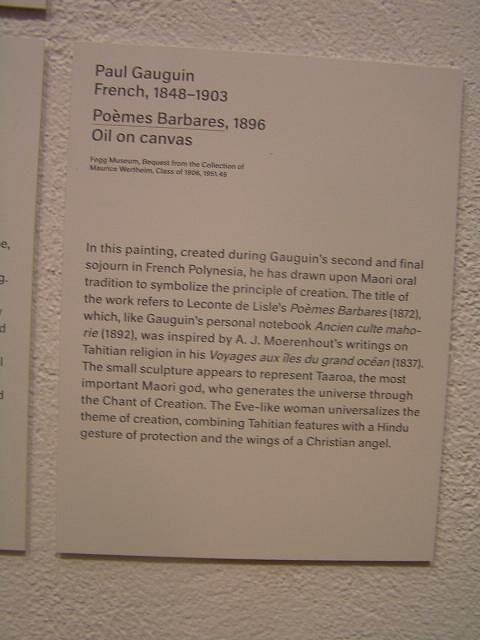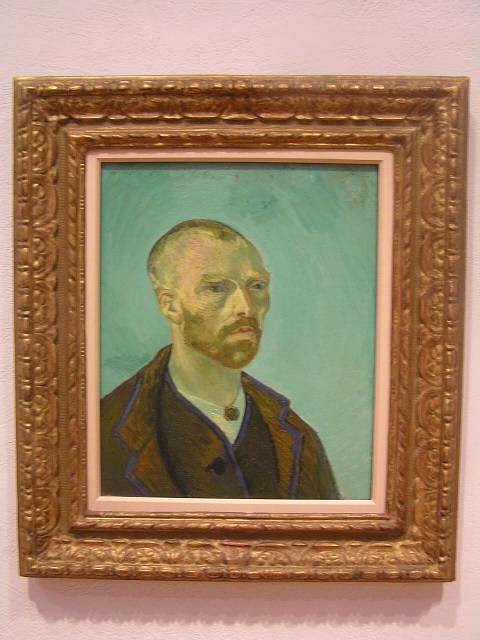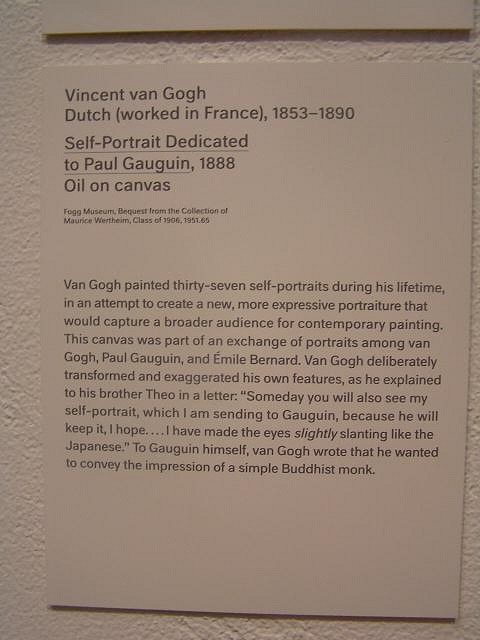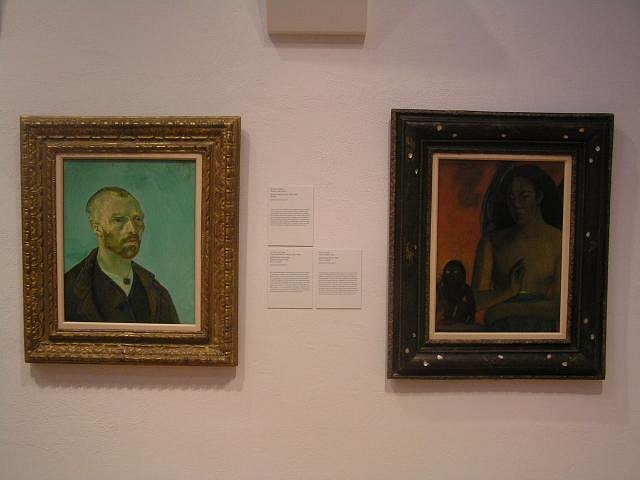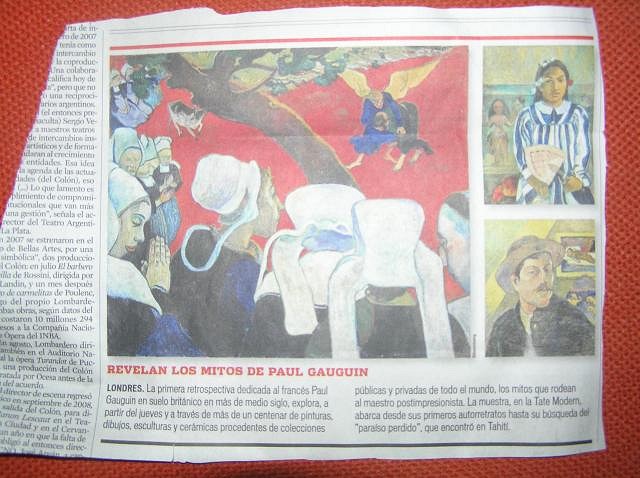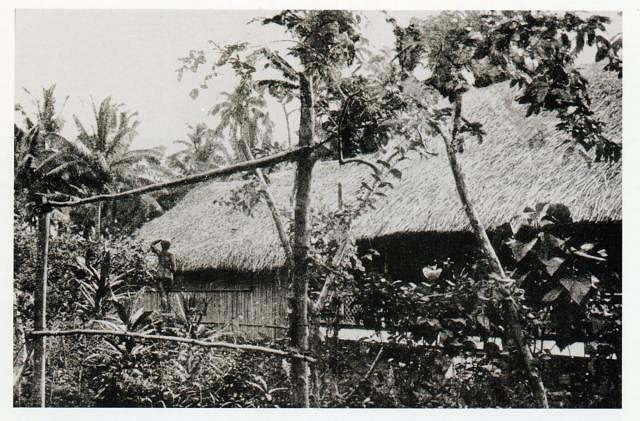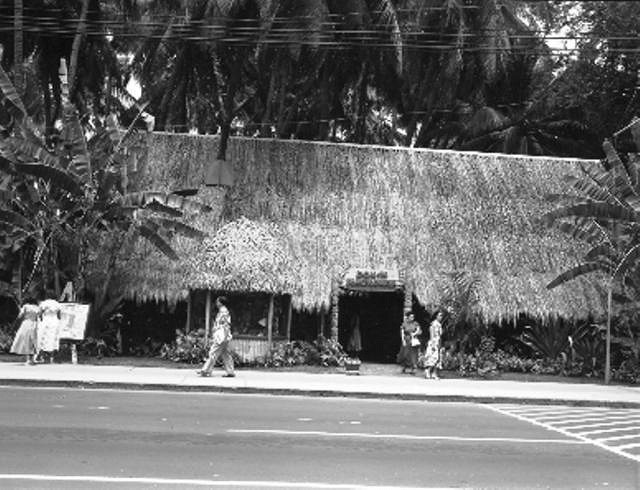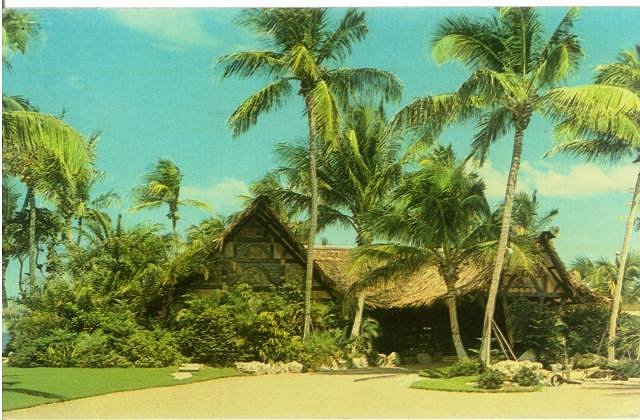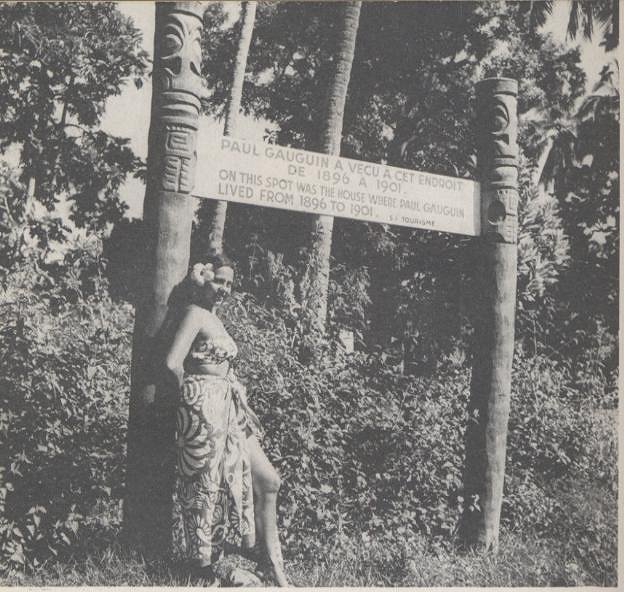Tiki Central / General Tiki
Paul Gauguin
|
Z
Zeta
Posted
posted
on
Tue, Mar 17, 2009 1:22 PM
This is where we will post everything about the French painter. Paul Gauguin Birth name Eugène Henri Paul Gauguin Eugène Henri Paul Gauguin (7 June 1848 – 8 May 1903) was a leading Post-Impressionist painter. His bold experimentation with coloring led directly to the Synthetist style of modern art while his expression of the inherent meaning of the subjects in his paintings, under the influence of the cloisonnist style, paved the way to Primitivism and the return to the pastoral. He was also an influential proponent of wood engraving and woodcuts as art forms.[1][2]
[edit] Life Paul Gauguin was born in Paris, France, to journalist Clovis Gauguin and half-Peruvian Aline Maria Chazal, the daughter of proto-socialist leader Flora Tristan. In 1851 the family left Paris for Peru, motivated by the political climate of the period. Clovis died on the voyage, leaving three-year old Paul, his mother and his sister to fend for themselves. They lived for four years in Lima, Peru, with Paul’s uncle and his family. The imagery of Peru would later influence Paul in his art. At the age of seven, Paul returned to France with his family. They moved to Orléans, France, to live with his grandfather. He soon learned French and excelled in his studies. At seventeen, Gauguin signed on as a pilot’s assistant in the merchant marine to fulfill his required military service. Three years later, he joined the navy where he stayed for two years. In 1871, Gauguin returned to Paris where he secured a job as a stockbroker. In 1873, he married a Danish woman, Mette Sophie Gad. Over the next ten years, they would have five children. Gauguin had been interested in art since his childhood. In his free time, he began painting. He also visited galleries frequently and purchased work by emerging artists. Gauguin formed a friendship with artist Camille Pissarro, who introduced him to various other artists. As he progressed in his art, Gauguin rented a studio, and showed paintings in Impressionist exhibitions held in 1881 and 1882. Over two summer vacations, he painted with Camille Pissarro and occasionally Paul Cézanne. By 1884 Gauguin had moved with his family to Copenhagen, where he pursued a business career as a stockbroker. Driven to paint full-time, he returned to Paris in 1885, leaving his family in Denmark. Without adequate subsistence, his wife (Mette Sophie Gadd) and their five children returned to her family. Gauguin outlived two of his children. In 1887, after visiting Panama, he spent several months near Saint Pierre in Martinique, in the company of his friend the artist Charles Laval. At first, the 'negro hut' in which they lived suited him and he enjoyed watching people in their daily activities.[3] However, the weather in the summer was hot and the hut leaked in the rain. He also got dysentery and marsh fever. While in Martinique, he produced between ten and twenty works (twelve being the most common estimate). While in Martinique, Gauguin traveled widely there and apparently came into contact with the small community of Indian immigrants, a contact that would later influence his art through the incorporation of Indian symbols. Like his friend Vincent Van Gogh, with whom in 1888 he spent nine weeks painting in Arles, Paul Gauguin experienced bouts of depression and at one time attempted suicide. Disappointed with Impressionism, he felt that traditional European painting had become too imitative and lacked symbolic depth. By contrast, the art of Africa and Asia seemed to him full of mystic symbolism and vigour. There was a vogue in Europe at the time for the art of other cultures, especially that of Japan (Japonism). He was invited to participate in the 1889 exhibition organized by Les XX. Under the influence of folk art and Japanese prints, Gauguin evolved towards Cloisonnism, a style given its name by the critic Édouard Dujardin in response to Emile Bernard's cloisonne enamelling technique. Gauguin was very appreciative of Bernard's art and of his daring with the employment of a style which suited Gauguin in his quest to express the essence of the objects in his art. In The Yellow Christ (1889), often cited as a quintessential Cloisonnist work, the image was reduced to areas of pure colour separated by heavy black outlines. In such works Gauguin paid little attention to classical perspective and boldly eliminated subtle gradations of colour, thereby dispensing with the two most characteristic principles of post-Renaissance painting. His painting later evolved towards Synthetism in which neither form nor colour predominate but each has an equal role. In 1891, Gauguin, frustrated by lack of recognition at home and financially destitute, sailed to the tropics to escape European civilization and "everything that is artificial and conventional." (Before this he had made several attempts to find a tropical paradise where he could 'live on fish and fruit' and paint in his increasingly primitive style, including short stays in Martinique and as a labourer on the Panama Canal construction, however he was dismissed from his job after only two weeks). Living in Mataiea Village in Tahiti, he painted "Fatata te Miti" ("By the Sea"),"Ia Orana Maria" (Ave Maria) and other depictions of Tahitian life. He moved to Punaauia in 1897, where he created the masterpiece painting "Where Do We Come From" and then lived the rest of his life in the Marquesas Islands, returning to France only once, when he painted at Pont-Aven. His works of that period are full of quasi-religious symbolism and an exoticized view of the inhabitants of Polynesia. In Polynesia he sided with the native peoples, clashing often with the colonial authorities and with the Catholic Church. During this period he also wrote the book Avant et après (before and after), a fragmented collection of observations about life in Polynesia, memories from his life and comments on literature and paintings. In 1903, due to a problem with the church and the government, he was sentenced to three months in prison, and charged a fine. At that time he was being supported by the art dealer Ambroise Vollard[4] He died of syphilis before he could start the prison sentence. His body had been weakened by alcohol and a dissipated life. He was 54 years old. Gauguin died in 1903 and is buried in Calvary Cemetery (Cimetière Calvaire), Atuona, Hiva ‘Oa, Marquesas Islands, French Polynesia. [edit] Historical significance Primitivism was an art movement of late 19th century painting and sculpture; characterized by exaggerated body proportions, animal totems, geometric designs and stark contrasts. The first artist to systematically use these effects and achieve broad public success was Paul Gauguin. The European cultural elite discovering the art of Africa, Micronesia, and Native Americans for the first time were fascinated, intrigued and educated by the newness, wildness and the stark power embodied in the art of those faraway places. Like Pablo Picasso in the early days of the 20th century, Gauguin was inspired and motivated by the raw power and simplicity of the so-called Primitive art of those foreign cultures. Gauguin is also considered a Post-Impressionist painter. His bold, colorful and design oriented paintings significantly influenced Modern art. Gauguin's influence on artists and movements in the early 20th century include Henri Matisse, Pablo Picasso, Georges Braque, André Derain, Fauvism, Cubism, and Orphism among others. John Rewald, one of the first art historians to focus on the birth of modern art, wrote about Post-Impressionism in his pioneering publication called Post-Impressionism: From Van Gogh to Gauguin (1956). Rewald considered it as a continuation of his earlier volume History of Impressionism (1946). In his book about the Post-Impressionists he limited the scope to the years between 1886 and 1892. Rewald mentioned that a "subsequent volume dedicated to the second half of the post-impressionist period"[5] - Post-Impressionism: From Gauguin to Matisse - was to follow, extending the period covered to other artistic movements of the late 19th and early 20th centuries, unfortunately he did not complete that volume. An interesting essay by John Rewald entitled Paul Gauguin-Letters to Ambroise Vollard and André Fontainas, (included in John Rewald Studies in Post-Impressionism, published by Abrams in 1986), discusses Gauguin's years in Tahiti, and the struggles of his survival as seen through correspondence with the dealer Vollard and others. [edit] Legacy The vogue for Gauguin's work started soon after his death. Many of his later paintings were acquired by the Russian collector Sergei Shchukin. A substantial part of his collection is displayed in the Pushkin Museum and the Hermitage. Gauguin paintings are rarely offered for sale; their price may be as high as $39.2 million US Dollars. Gauguin influenced many other painters, but one especially notable connection is his imparting to Arthur Frank Mathews the use of an intense color palette. Mathews met Gauguin in the late 1890s while both were at the Academie Julian. Mathews took this influence in his founding of the California Arts and crafts or California Decorative movement. The Japanese styled Gauguin Museum, opposite the Botanical Gardens of Papeari in Papeari, Tahiti, contains some exhibits, documents, photographs, reproductions and original sketches and block prints of Gauguin and Tahitians. In 2003, the Paul Gauguin Cultural Center opened in Atuona in the Marquesas Islands. Paul Gauguin's life inspired Somerset Maugham to write The Moon and Sixpence. It is also the subject of at least two operas: Federico Elizalde's Paul Gauguin (1943), and Gauguin (a synthetic life) by Michael Smetanin and Alison Croggon. Déodat de Séverac wrote his Elegy for piano in memory of Gauguin. Mario Vargas Llosa has also based his 2003 novel The Way to Paradise on Gauguin's life. Paul Gauguin is referred to in Calvin and Hobbes by Bill Watterson. Calvin is seen walking past his mother, shouting "Paul Gauguin once said, 'Where do we come From? What are we? Where are we going?'" Then, a couple of panels over, Calvin comes back and asks, "Who the heck is Paul Gauguin anyway?" Gauguin has been sainted by the Ecclesia Gnostica Catholica, a modern revival of Gnosticism.[citation needed] |
|
Z
Zeta
Posted
posted
on
Tue, Mar 17, 2009 1:27 PM
Bodegon con estampa japonesa. 1889 |
|
Z
Zeta
Posted
posted
on
Tue, Mar 17, 2009 1:30 PM
Self-portrait mug. |
|
Z
Zeta
Posted
posted
on
Tue, Mar 17, 2009 1:34 PM
|
|
Z
Zeta
Posted
posted
on
Tue, Mar 17, 2009 1:42 PM
From an Spanish sticker album. |
|
Z
Zeta
Posted
posted
on
Tue, Mar 17, 2009 2:31 PM
Noa Noa |
|
Z
Zeta
Posted
posted
on
Tue, Mar 17, 2009 2:35 PM
|
|
Z
Zeta
Posted
posted
on
Tue, Mar 17, 2009 2:37 PM
From Noa Noa: |
|
Z
Zeta
Posted
posted
on
Tue, Mar 17, 2009 2:40 PM
Charles Chasse |
|
S
Son-of-Kelbo
Posted
posted
on
Tue, Mar 17, 2009 3:45 PM
Great post, Zeta! We daily enjoy a view of Gauguin's "Tahiti" in our dining room --
Hopefully this thread will attract the same focus to PG's work that the M.Covarrubias thread has for that worthy artist... |
|
I
ikitnrev
Posted
posted
on
Tue, Mar 17, 2009 7:50 PM
I've been on a Gauguin kick over the last couple of years - it started when I purchased a replica of a Gauguin print from the Jack Lord estate sale, and I thought I should learn more of the artist. (I have a small collection of Covarrubias books too) I have since then purchased several books about Gauguin - unfortunately I haven't read them yet, so can add no further details on his life, but catch me in a few years! Here is a brief summary of what I already have - there are many other books on Gauguin out there besides these.
The book's title refers to the quote "so busy yearning for the moon that he never saw the sixpence at his feet" meaning that the artist's yearning to find a true idealistic view of art and beauty overpowers his ability to sustain human relationships and appreciate the ordinary pleasures of life. Vern [ Edited by: ikitnrev 2009-03-17 20:06 ] |
|
T
tiki-riviera
Posted
posted
on
Wed, Mar 18, 2009 10:42 AM
In an ironic twist Edgar Leeteg's son Edgar Jr. is a tour guide in Tahiti giving tours of the island including information about Paul Gaugin, instead of his father whom I consider a much more interesting artist. Thats life. |
|
B
bigbrotiki
Posted
posted
on
Wed, Mar 18, 2009 3:04 PM
Indeed, Zeta, a nice long post on one of my pet subjects! Some, but few, Polynesian bars used Gauguin's art as decor. Here is a well-known example from the BOT, this time in full size, from Tiki Bob's:
There also is a dive bar (forgot the name) on the Florida coast that has some very nice Gauguin murals. Paul Gauguin actually died on Hiva Oa in the Marquesas Islands, in 1903. He had moved there to escape the "fake French atmosphere" of Papeete. Here is my son Diego at his grave in 2002:
I have always been intrigued by the fact that, though he was the first to utilize the dream of the Polynesian lifestyle as an anti-bourgeois, bohemian ideology in his life and work, he rarely employed Polynesian art to do so. Though he did sketch Polynesian sculpture in his sketchbooks, he did not copy it directly to his paintings. Most of his depictions of "idols" and "gods" were symbolically stylized into Asian or humanoid figures:
Maybe the time was not ripe yet for primitive art. Or was he distracted by something else? :D
In 1895, on his second trip to Tahiti, Gauguin spent 10 days in New Zealand and made several sketches of Maori Tiki carvings he saw at the Auckland museum:
He also copied some Marquesan Tikis from photos:
Here is a recent photo of Takai, the largest Marquesan stone Tiki, (and me in 2002):
I can only think of ONE painting where Gauguin directly referenced a Tiki statue, his 1897 "The Idol":
It clearly is taken from this Maori gateway carving (Gauguin probably obtained a photo of it at the Auckland museum):
Interestingly, this is the statue that is featured in the movie version of "The Moon and the Sixpence", on Strickland's (Gauguin's) table in Paris, and at the end of the film, engulfed in flames.
I really love Gauguin's CARVINGS, which though again never full-fledged Tikis, are THE first Western interpretations of Polynesian sculpture:
[ Edited by: bigbrotiki 2009-03-18 15:06 ] |
|
Z
Zeta
Posted
posted
on
Wed, Mar 18, 2009 9:57 PM
At first, I didn't liked it, but now I like it a lot. Like beer. Great pictures everyone! |
|
Z
Zeta
Posted
posted
on
Mon, Mar 23, 2009 9:01 PM
The Gauguin Tiki... |
|
C
captnkirk
Posted
posted
on
Tue, Mar 24, 2009 4:07 AM
I posted this a while a ago in the "Tikis in Films thread", but I thought this would be a good place for it as well. I saw one recently on DVD. It was called Paradise Found, it is a biopic about the life of painter Paul Gauguin. Half the film takes place in Paris where he quits a lucrative job as a stock broker and becomes a painter. The other half is in French Polynesia where he paints the people and places that surround him. He has conflicts with his wife over quitting his job and his painting, he has conflicts with the local priest in Tahiti about the destruction of tikis (false idols) on the island. I would not buy a copy of it, but it is worth a rental if you like movies about paradise. From what I know about him it is pretty close to the facts too.
|
|
KBT3

King Bushwich the 33rd
Posted
posted
on
Tue, Mar 24, 2009 9:16 AM
Another movie about him. |
|
B
bigbrotiki
Posted
posted
on
Tue, Mar 24, 2009 11:12 AM
This is confusing to me. I don't believe his remains were ever moved, but where is that tombstone from? Here is another shot I took of his grave at the Altuona Cemetery, on a hilltop on the Marquesan island of Hiva Oa:
The statue on the grave is a replica of his ceramic sculpture called "Oviri":
Here is a reference to why it is on his grave, (quoting him before he decided to leave Tahiti):
Though he sometimes gave his human subjects Tiki-esque facial features...
...he was definitely more obsessed with the female form, as can be seen in his most famous wood carvings, the door boards to his studio on Hiva Oa, which he called his "House of Pleasure":
Here is their complete set up: Here is a sketch of his home on Hiva Oa, the studio was upstairs: [ Edited by: bigbrotiki 2009-03-24 13:25 ] |
|
PA
Pacific Andy
Posted
posted
on
Tue, Mar 24, 2009 12:55 PM
There is always been a rumour in Tahiti in the town of Punaaia where he lived that when he left for the Marques Islands he left so much debt that the local ransacked his little house. Someone took the door where he painted a mural of the beach in Punaaia. The rumour is that someone on the island of Moorea has that door. Can you imagine how much it would be worth? |
|
Z
Zeta
Posted
posted
on
Fri, Mar 27, 2009 11:02 AM
Nice post Bigbro!
In the prologue of a recent edition of NOA NOA the person who wrote the prologue tells the story of how he goes to where Gauguin's house door was and bought it from a local... So probably, the door is in some museum or collection somewhere, not in the wild... It is funny and poetic... He left that house broke and in debt and eventually someone took the door and sold it for a lot of pesos... |
|
TD
Tiki Duddy
Posted
posted
on
Sat, Mar 28, 2009 6:46 AM
Thanks for the InfoLoad, Zeta! |
|
B
bigbrotiki
Posted
posted
on
Sat, Mar 28, 2009 3:27 PM
Here is the reproduction of Paul Gauguin's studio on Hiva Oao:
And here is the VIEW from his grave:
Both from this great website: |
|
Z
Zeta
Posted
posted
on
Sat, Mar 28, 2009 11:11 PM
Cool Bigbro!
|
|
Z
Zeta
Posted
posted
on
Wed, Apr 1, 2009 5:47 PM
|
|
Z
Zeta
Posted
posted
on
Tue, Apr 7, 2009 12:26 PM
Vintage Postcard |
|
Z
Zeta
Posted
posted
on
Wed, Apr 8, 2009 8:48 AM
Guess who... |
|
Z
Zeta
Posted
posted
on
Tue, Apr 14, 2009 10:53 AM
|
|
HJ
Haole Jim
Posted
posted
on
Mon, Jul 20, 2009 11:06 PM
Incredibly cool, thank you. There are a number of Gauguin originals in the collection of the Art Institute of Chicago, on the central coast (the Great Lakes). |
|
Z
Zeta
Posted
posted
on
Thu, Jan 21, 2010 4:38 PM
Aloha everyone! Interesting article mentions the "Gauguin Room" From 1964 to 1969 in N.Y.C. From "Some NYC Tiki History" thread posted by leisure master: From the New York Times January 20, 2010, 4:34 pm In 1994, Ruth Reichl announced that New York had outgrown tiki bars. Her review of Gauguin, a French-Polynesian fusion palace that briefly occupied the basement of the Plaza Hotel, ended on the image of two exiting customers: a delighted child and her somber father. He was somber, perhaps, because he had had to foot the bill in a restaurant that paid rent to Donald Trump. More important, he was too old to believe in “silly drinks and fake palms.” Yet, for most of its history, tiki culture has been a singularly grown-up pursuit. After all, those “silly drinks”—providing you can find the straw through the thicket of fruit salad and plastic effigies—offer what Craig Claiborne called “unrivalled potency.” And the pineapple-happy fare that typically accompanies it was once capable of earning three stars from The New York Times. That three-star tiki bar was named the Gauguin Room. From 1964 to 1969, in the ninth-floor penthouse of the now-defunct Gallery of Modern Art (the building at 2 Columbus Circle that now houses the Museum of Art and Design), it served liberally interpreted Polynesian to a Park Avenue crowd. The menu was an anthropological marvel of arbitrary Tahitian references and nonsense pidgin—“Papeete” referred to Cornish game hen, and a chow mein dish was sold as “Pork Ding Dong”—but apparently it all tasted good, and the cocktails were enormous. Nobody really thought it was authentic, least of all Craig Claiborne, who described the food as a pan-Asian fantasy. He gave it a glowing review anyway. The Gauguin that Ruth Reichl reviewed thirty years later was, in many ways, the same restaurant—but times had changed. In 1964, Hawaii had recently achieved statehood, “Gilligan’s Island” was in its first season, and, in the name of Polynesian cookery, canned pineapple was infiltrating everything from cheese sandwiches to meatballs. In 1994, a year notable for Ms. Reichl’s multi-starred reviews of a Chinatown noodle house and no-frills sushi bar, New Yorkers no longer wanted to be condescended to with pastiche. The kitchen’s fusion acrobatics— foie gras rumaki, Yang Chow couscous, and fruit sushi with marzipan “wasabi,”—fell flat, and the island exotica that had spelled tropical adventure to a generation of diners not yet accustomed to air travel now recalled a school gym decked out for luau prom. This year, two forthcoming neo-Polynesian ventures—Hurricane Club, which will open in the Park Avenue location once occupied by Porçao, and Painkiller, from the team behind Dutch Kills in Long Island City—are banking on the return of our lost innocence, or at least a willingness to suspend disbelief. The rum will certainly go a long way, and economic uncertainty may do the rest. Tough times have a way of calling for comfort food and uncomplicated fun. Should you doubt the consoling power of the tiki bar, consider the case of kidnapped heiress Patty Hearst. When she was reunited with her family after her ordeal at the hands of the Symbionese Liberation Army, the first thing she asked for was a mai tai. |
|
Z
Zeta
Posted
posted
on
Sat, Jan 23, 2010 4:36 AM
From the "Port Aventura Barcelona Spain" thread:
|
|
Z
Zeta
Posted
posted
on
Thu, Mar 25, 2010 6:10 AM
Where do we come from? What are we? Where are we going? From the Museum of Fine Arts in Boston: Aah, those crazy artists... |
|
LLT
little lost tiki
Posted
posted
on
Thu, Mar 25, 2010 7:37 AM
too bad he died before the mai-Tai was invented.... Great thread Zeta! and that Kiefer Sutherland movie is pretty good... |
|
Z
Zeta
Posted
posted
on
Wed, Apr 7, 2010 4:38 AM
Merci Liloti! More from the MFA in Boston: |
|
Z
Zeta
Posted
posted
on
Fri, Jun 11, 2010 10:23 PM
Harvard Art Museum in Cambridge Mass. |
|
HJ
Haole Jim
Posted
posted
on
Sat, Jun 12, 2010 8:34 AM
There a a few paintings and sculptures in the Art Institute of Chicago; must-sees at every visit. Wternal thanks to Paul Gauguin for leavin this magnificent art...even if he was a bit wacked in the head. |
|
Z
Zeta
Posted
posted
on
Mon, Jul 5, 2010 10:45 PM
Harvard Art Museum in Cambridge Mass. |
|
B
bigbrotiki
Posted
posted
on
Tue, Jul 6, 2010 8:43 AM
I didn't know that, very interesting. The two paintings look good together. That supposed Maori piece looks more like a monkey, or the eyes and nose could be PNG style. Paul sure tried every style in his depictions of Polynesian carvings, all to avoid being too literal. |
|
V

virani
Posted
posted
on
Tue, Jul 6, 2010 11:25 AM
I also visited the reproduction house and cemetary where he is buried at, in Hiva Oa, next to the famous Belgium singer Jacques Brel. |
|
Z
Zeta
Posted
posted
on
Thu, Jul 8, 2010 5:47 AM
|
|
Z
Zeta
Posted
posted
on
Mon, Oct 11, 2010 2:16 PM
|
|
Y
yuriart10
Posted
posted
on
Thu, Oct 21, 2010 7:32 PM
I like it. [ Edited by: Bora Boris - Spam links removed. - 2010-10-21 22:20 ] |
|
B
bigbrotiki
Posted
posted
on
Thu, Oct 21, 2010 10:05 PM
And we don't like spam. |
|
Z
Zeta
Posted
posted
on
Wed, Nov 3, 2010 11:04 AM
I read on the EL PAIS newspaper that when he died (P. Gaugin), a cannibal friend bited him in the leg to have some of his spirit to live on. Sure did. What a good friend... |
|
Z
Zeta
Posted
posted
on
Tue, Nov 9, 2010 10:17 PM
"El paraiso en la otra esquina" |
|
B
bigbrotiki
Posted
posted
on
Wed, Nov 10, 2010 12:27 AM
Found in a Sotheby's Auction catalog:
Gauguin's palm hut in Punaauia, a "suburb" of Papeete on Tahiti
1st Don the Beachcomber's in Waikiki
Frances Langford's Outrigger in Florida If these places were Pre-Tiki, Gauguin's hut was ....Proto-Tiki! :D |
|
MN
Mister Naufrago
Posted
posted
on
Thu, Nov 11, 2010 10:17 AM
This 70's Gauguin´s house photography includes signage that makes it look even closer to that Don the Beachcomber´s place. :)
|
|
RR
Rum Runner
Posted
posted
on
Thu, Sep 15, 2011 9:08 PM
NEW SHOW FOR 2012 GAUGUIN AND POLYNESIA: AN ELUSIVE PARADISE AT SEATTLE ART MUSEUM FEBRUARY 9 - APRIL 29 2012 ONLY U.S. VENUE |
|
J
JONPAUL
Posted
posted
on
Fri, Sep 16, 2011 10:40 AM
For a real Gauguin eye-candy feast, check out Gauguin: Life, Art Inspiration (Abrams: 1987).
|

